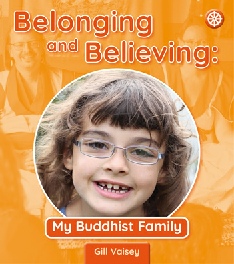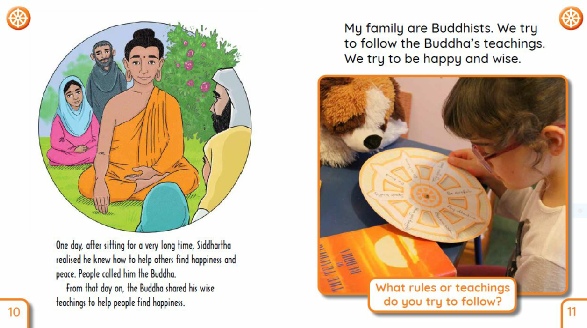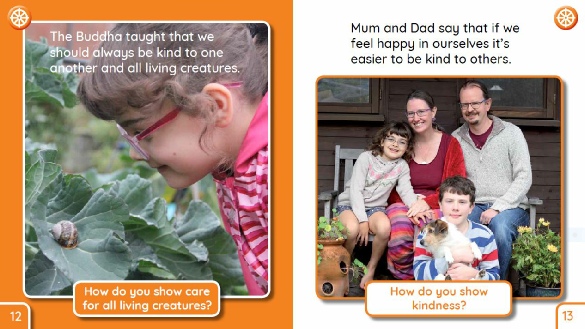







HOME | ABOUT US | RE-THINK TOPIC PACKS | ENGLISH BOOKS | BELONGING & BELIEVING| | WELSH BOOKS | SOFT TOYS | SPECIAL OFFERS | ORDERING | FREE TEACHERS RESOURCES | INSET COURSES & INFORMATION | PHOTO STORY | CUSTOMER REVIEWS | CONTACT US |
Delivery information | Postage and Packing | Returns Policy | VAT | Privacy Policy









Transform your RE with Belonging and Believing.
Explore the real lives of eight children each from a different religion or worldview.
Meet Caitlin and her Buddhist family:

Caitlin and her family follow the Tibetan Vajrayana Buddhist tradition and in particular the Aro gTér lineage. Within their lineage, music (both singing and instrumental) can be used as a meditation technique in itself and also to complement silent sitting meditation. Caitlin particularly likes playing Himalayan musical instruments such as the drilbu (bell), chod drum, dungchen (great horn), conch, and the silnyen and rolmo (peaceful and wrathful cymbals).

Buddhism started with the birth of Prince Siddhartha Gautama around 563BCE, who became the Buddha Shakyamuni. He led a privileged life of luxury and his parents sheltered him from the outside world and its usual sufferings of sickness, old age and death. As an adult, he went outside the palace grounds and for the first time saw an old man, a sick man, and a corpse. He learned that these conditions were an inevitable part of human life. Siddhartha practised meditation and lived an extreme life of asceticism for six years but found that this did not give him the answers that he sought. He gave up this extreme state of poverty. One day whilst sitting under a Bodhi tree Siddhartha became deeply absorbed in meditation and finally achieved enlightenment and became known as the first or first of many Buddhas of this age.
He realised that living in the middle way between luxury and poverty was necessary in order to find a peaceful state of mind.


The Buddhist way of life is one of peace, loving kindness and wisdom. The Buddha Shakyamuni taught that all problems and suffering arise from confused and negative states of mind, and that all happiness and good fortune arise from peaceful and positive states of mind.
The Buddha taught methods for gradually overcoming negative minds such as anger, jealousy and ignorance, and developing positive minds such as love, compassion and wisdom. Through this practice Buddhists aim to experience lasting wisdom and compassion. With wisdom and compassion, kindness naturally arises and with it, feelings of happiness, peacefulness and contentment.
| My Bahá’í Family |
| My Buddhist Family |
| My Christian Family |
| My Hindu Family |
| My Humanist Family |
| My Jewish Family |
| My Muslim Family |
| My Sikh Family |
| Video files Belonging and Believing |